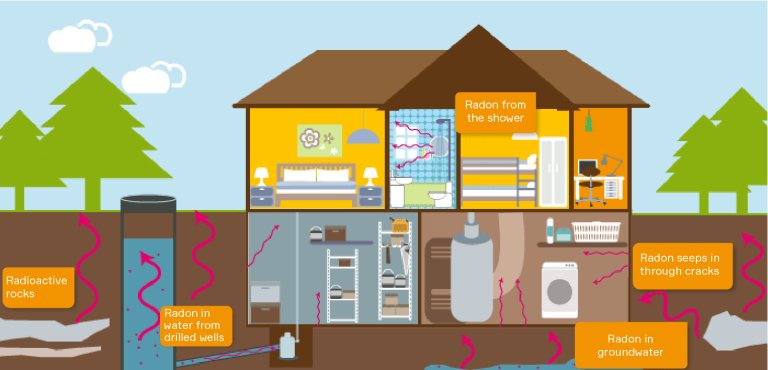IN SHORT
You should measure radon in your domestic water if:
- you have measured high radon levels in the indoor air and take your water from a well
- you have a drilled well in solid rock
Radon gas forms naturally in the bedrock and both ground air and groundwater contain radon. In surface water, the radon level is low. The highest radon concentrations have been found in water from private wells drilled in solid rock.
Radon in water can be a cause of elevated radon concentrations in indoor air. A well drilled in rock is an almost closed system where the gas is released when you use the water indoors in a shower or washing machine, for example. This can lead to increased radon levels in the indoor air.
The highest radon concentrations are found in Østfold, Vestfold, Aust-Agder and in Hordaland, in areas with uranium-rich granites and gneiss.

Is radon in water dangerous?
High radon concentrations in water will raise the levels of radon in indoor air and increase the risk of lung cancer. The risk will depend on the radon concentration, your water consumption, how long time you spend indoors and the ventilation.
A good rule of thumb is that a radon concentration in the water of 1000 Bq/l (becquerels/litre) will contribute around 100 Bq/m³ to the indoor air.
Water containing radon which you drink can also give radiation doses to the body, but these are small compared to the doses you receive by inhalation of radon in air.
Measuring radon in water
You should measure radon in your domestic water if:
- you have measured high radon levels in the indoor air and take your water from a well
- you have a drilled well in solid rock
Radon analysis of water can be carried out all year round.
Action level for radon in water
DSA recommends taking action if your domestic water has a radon content of more than 500 Bq/l. The recommendation applies to an individual household with its own water supply. For water works, there is a statutory limit value of 100 Bq/l.
- Regulations on Certain Contaminants in Food (in Norwegian only)
Measures to reduce radon in water
There are several ways of reducing the radon content in water. None of the methods can completely remove radon, but some solutions have shown a reduction effect of at least 95 %. The solutions available use aeration, storage and filtration. These methods can also be combined. In households with normal water consumption, systems using aeration are most common.
Aeration
One of the most effective methods of reducing radon content in large volumes of water is to mix water with air, so that the radon gas is released. This can be done by different forms of bubbling, dispersion or sprinkling.
Storage
Radon has a half-life of 3.8 days, and storing water will cause the radon gas to disappear over time. The radon concentration will halve every four days. However, storage can encourage the growth of bacteria and require chlorine to be added.
Filtration
There are various filtration methods that can reduce the radon content in water. The two most widely used methods are membrane filtration (reverse osmosis) and filtration through activated charcoal. These methods are only suitable for limited consumption of water (drinking water) and not for water to be used in washing machines, dishwashers, showers, etc. They can also cause a build-up of long-lived radon decay products on the filters, which may then have to be treated as radioactive waste.
Advisers and providers of measures
There are a number of different systems on the market for treating water containing radon in the Nordic region, and the solutions are often a combination of several of the above methods. We recommend weighing effectiveness against cost and obtaining quotations with a guarantee of effectiveness in any given case.
- List of advisers and providers.
There is no public approval system, and the information is based on the companies’ own advertising material. DSA does not recommend any one particular company.
